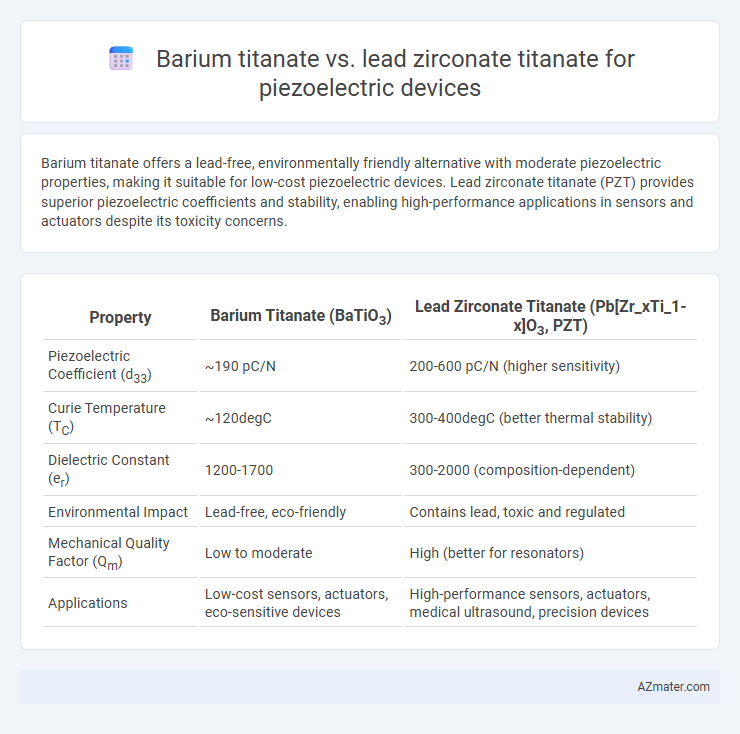Barium titanate offers a lead-free, environmentally friendly alternative with moderate piezoelectric properties, making it suitable for low-cost piezoelectric devices. Lead zirconate titanate (PZT) provides superior piezoelectric coefficients and stability, enabling high-performance applications in sensors and actuators despite its toxicity concerns.
Table of Comparison
| Property | Barium Titanate (BaTiO3) | Lead Zirconate Titanate (Pb[Zr_xTi_1-x]O3, PZT) |
|---|---|---|
| Piezoelectric Coefficient (d33) | ~190 pC/N | 200-600 pC/N (higher sensitivity) |
| Curie Temperature (TC) | ~120degC | 300-400degC (better thermal stability) |
| Dielectric Constant (er) | 1200-1700 | 300-2000 (composition-dependent) |
| Environmental Impact | Lead-free, eco-friendly | Contains lead, toxic and regulated |
| Mechanical Quality Factor (Qm) | Low to moderate | High (better for resonators) |
| Applications | Low-cost sensors, actuators, eco-sensitive devices | High-performance sensors, actuators, medical ultrasound, precision devices |
Introduction to Piezoelectric Materials
Barium titanate (BaTiO3) and lead zirconate titanate (PZT) are key piezoelectric materials widely used in sensors, actuators, and transducers due to their ability to convert mechanical stress into electrical charge. Barium titanate is a lead-free ceramic with moderate piezoelectric coefficients and is preferred for environmentally friendly applications. Lead zirconate titanate exhibits higher piezoelectric sensitivity and stability, making it the material of choice for high-performance piezoelectric devices in industrial and medical fields.
Overview of Barium Titanate (BaTiO₃)
Barium titanate (BaTiO3) is a ferroelectric ceramic material widely used in piezoelectric devices due to its high dielectric constant and strong piezoelectric properties. It exhibits excellent temperature stability and can operate efficiently in a range of electrical applications, including actuators and sensors. Compared to lead zirconate titanate (PZT), BaTiO3 is lead-free, making it an environmentally friendly alternative for piezoelectric device manufacturing.
Overview of Lead Zirconate Titanate (PZT)
Lead Zirconate Titanate (PZT) is a widely used piezoelectric ceramic known for its superior piezoelectric properties, including high piezoelectric coefficients and electromechanical coupling factors, which outperform Barium Titanate (BaTiO3). PZT's excellent temperature stability and tunable dielectric constants make it ideal for sensors, actuators, and transducers in advanced piezoelectric devices. Its complex perovskite structure with a mixed lead zirconate and lead titanate composition enables enhanced polarization and mechanical response critical for high-performance applications.
Crystal Structure and Composition Comparison
Barium titanate (BaTiO3) exhibits a perovskite crystal structure with a tetragonal phase at room temperature, characterized by a non-centrosymmetric arrangement ideal for piezoelectricity, while lead zirconate titanate (Pb[Zr_xTi_1-x]O_3 or PZT) has a complex perovskite structure with a morphotropic phase boundary (MPB) between rhombohedral and tetragonal phases, enhancing its piezoelectric properties. BaTiO3 is composed mainly of barium, titanium, and oxygen, making it lead-free and environmentally friendly, whereas PZT contains lead, zirconium, titanium, and oxygen, with the lead content contributing to superior electromechanical coupling coefficients. The compositional flexibility of PZT allows tuning of the Zr/Ti ratio to optimize piezoelectric performance, surpassing BaTiO3 in sensitivity and stability for high-performance piezoelectric devices.
Piezoelectric Properties: Efficiency and Sensitivity
Barium titanate exhibits moderate piezoelectric efficiency and sensitivity suitable for low to medium power applications due to its relatively lower piezoelectric coefficients (d33 ~190 pC/N). Lead zirconate titanate (PZT) offers superior piezoelectric performance with higher efficiency and sensitivity, characterized by significantly larger piezoelectric coefficients (d33 up to 600 pC/N), making it the preferred material for high-precision and high-output piezoelectric devices. The enhanced polarization and domain wall mobility in PZT contribute to its exceptional electromechanical coupling factors, surpassing those of barium titanate.
Temperature Stability and Operating Ranges
Barium titanate (BaTiO3) exhibits moderate temperature stability with a Curie temperature around 120degC, making it suitable for low to moderate temperature applications in piezoelectric devices. Lead zirconate titanate (PZT) offers superior temperature stability, with a higher Curie temperature typically between 200degC and 350degC, allowing operation in harsher thermal environments. PZT's broad operating temperature range and enhanced piezoelectric coefficients make it the preferred choice for high-performance, temperature-critical piezoelectric sensors and actuators.
Environmental and Toxicity Considerations
Barium titanate (BaTiO3) is favored over lead zirconate titanate (PZT) in piezoelectric devices due to its lower environmental impact and non-toxic composition, eliminating concerns related to lead contamination. PZT contains lead, a heavy metal with significant toxicity and environmental hazards, leading to stricter regulations and disposal challenges. The shift towards BaTiO3 supports sustainable device manufacturing while ensuring compliance with environmental safety standards.
Applications in Piezoelectric Devices
Barium titanate (BaTiO3) exhibits strong dielectric properties and is commonly used in capacitors and low-frequency piezoelectric devices, offering lead-free advantages for environmentally sensitive applications. Lead zirconate titanate (PZT) demonstrates higher piezoelectric coefficients and electromechanical coupling, making it the preferred material for high-performance actuators, sensors, and ultrasonic transducers in medical and industrial devices. PZT's superior piezoelectric response supports a broader frequency range and greater sensitivity, whereas BaTiO3 is favored for eco-friendly applications where lead toxicity is a concern.
Cost and Manufacturing Differences
Barium titanate (BaTiO3) offers a lower-cost alternative to lead zirconate titanate (PZT) due to the absence of toxic lead, reducing environmental compliance expenses during manufacturing. PZT, however, demonstrates superior piezoelectric properties, often justifying its higher production costs in applications demanding enhanced sensitivity and performance. Manufacturing BaTiO3 generally involves simpler processes and lower raw material costs, while PZT requires stricter handling protocols and advanced sintering techniques, increasing overall fabrication complexity.
Future Trends and Research Directions
Research in piezoelectric devices increasingly prioritizes lead-free alternatives, positioning barium titanate (BaTiO3) as a promising candidate due to its environmental compatibility and favorable dielectric properties. Advances in material engineering aim to enhance BaTiO3's piezoelectric coefficients and temperature stability to rival lead zirconate titanate (PZT), which currently dominates piezoelectric applications because of its superior electromechanical coupling. Future research focuses on doping strategies, composite formulations, and nanoscale structuring to optimize BaTiO3 performance, targeting sustainable and high-efficiency piezoelectric sensors, actuators, and energy harvesters.

Infographic: Barium titanate vs Lead zirconate titanate for Piezoelectric device
 azmater.com
azmater.com